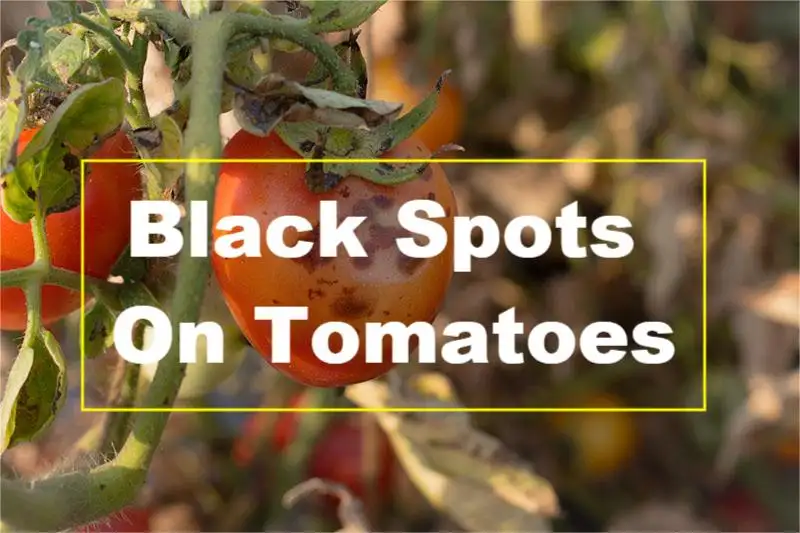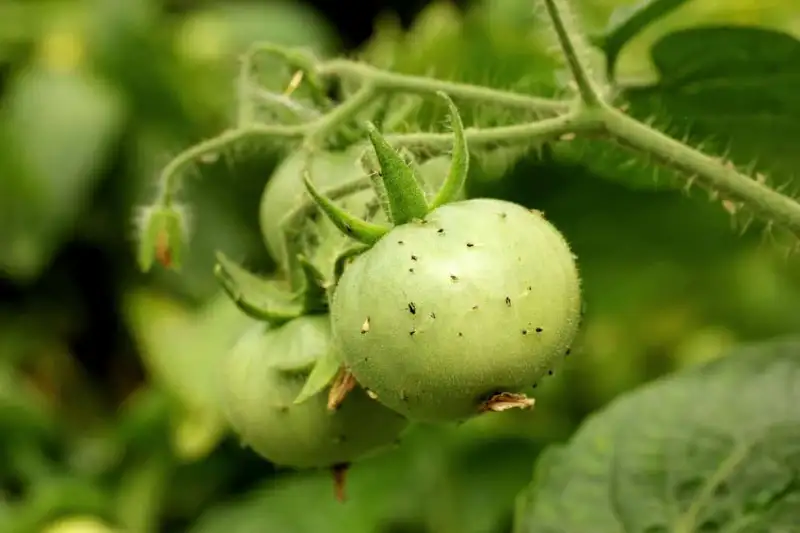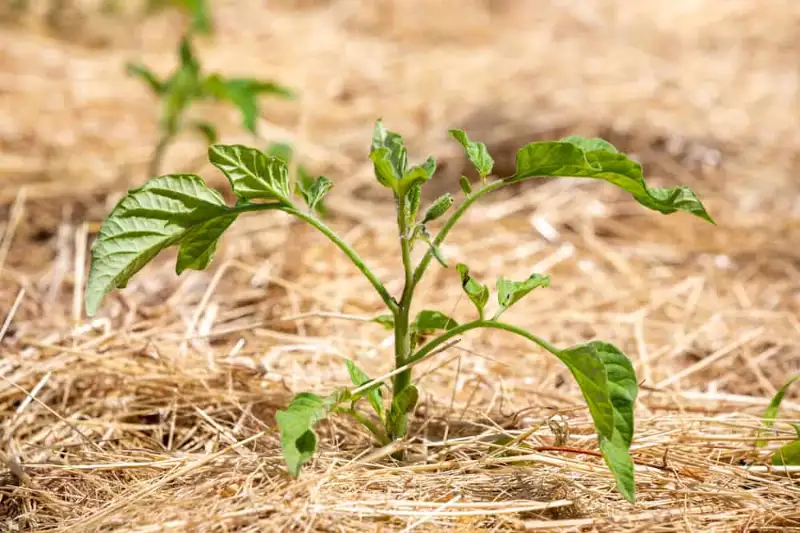Don’t you HATE it when you see black spots on tomatoes? We feel you. We know the pain and agony a tomato grower goes through when you see them. We want you to grow FRESH and HEALTHY tomatoes, so we have prepared the ULTIMATE guide for you.
Thanks to our years of gardening experience, we have a river of information about tomato plants. Those years of data are all yours in our guide. With this, you won’t ever have to wonder why your tomatoes developed black spots.
HECK, they won’t have black spots EVER again if you carefully follow our guides!
We’ll walk you through reasons, identification, and tips on avoiding any black spot causes. One read, and you won’t ever have to go through your trouble!

Reasons Why Black Spots on Tomatoes
It feels like we’re talking about the black plague! Well, having black spots in tomatoes is as horrific as that. Here are some of the reasons for this alarming sign:
Tomato Blossom End Rot

Tomatoes aren’t frivolous. They’re sensitive, and a calcium deficiency in the plant can lead to blossom end rot. BE CAREFUL when you’re looking out for your plants. Other reasons can include inconsistent watering or a low soil pH.
Lower soil pH level is indirectly linked to a problem with calcium absorption. Look out for the black spots at the bottom of your fruits before the entire fruit becomes inedible.
Pro Tip: Get yourself calcium sprays for your plant to absorb calcium.
Fungal Diseases

Let’s list several Fungal diseases before we talk about this.
- Early blight
- Late blight
- Anthracnose
- Septoria leaf spot
These fungal pathogens are the death of tomatoes! They’re usually spread through water, soil, and plant debris. YIKES! Look out for this fungal pathogen as they develop black spots on leaves, stems, and fruit too.
Insect Damage

Let’s make a list, shall we?
- Stink bugs
- Aphids
- Fruit flies
Stink bugs, well, even their name suggests keeping them away from your plants! They cause black spots, while aphids spread viruses that cause plant discoloration. Fruit flies love fruits if it isn’t evident from their name. They lay eggs on the tomato, which their larvae feed and hatch on.
Ensure you’re practicing proper pest management to prevent damaging tomato plants.
How to Identify the Causes of Tomatoes Black Spots?

From tomato diseases, insect damage, and blossom end rot, everything causes black spots. Identifying what drives them is the tricky part. Let’s dive into the steps needed to identify them.
Observe the location
You need to observe where the black spots appear. This will give you an idea of what’s causing the problem. Let’s get a little Sherlock Holmes in this scene.
- Black spots on Bottom – Blossom end rot
- Black spots on top or sides – Fungal disease or insect damage
Other disease signs
You don’t want to rule out anything until you dissect the issue. These black spots can be symptoms of other tomato-related diseases. But stay calm; that’s why we’re here!
You should look for other signs, like yellowing leaves, wilting or deformed fruit. Fungal disease can also cause spots on the leaves and stems and a white powdery coating. If there’s a white coating, chances are that your tomatoes are too damp and humid.
Look for other signs of disease or insect damage. Insect Infected plants will have holes in the leaves or on the fruit, so keep a lookout for infected fruit.
Check the soil
Tomatoes sure like slightly acidic soil, but too low ph soil can cause problems. For this, ensure you get a soil test for its pH levels. The pH soil condition should lie anywhere between 6.0 to 6.8.
Soil moisture is another crucial factor to observe. Fungal diseases are more likely to spread if the tomato plant grows in humid and damp conditions.
Watering
Are you sure you’re watering your tomato plants just the right amount? Consistency is key. Inconsistent watering will cause blossom end rot in your tomato plant. You most certainly want to stay away from that.
Consistent rainy weather is also bad for the plant; cover them up! Don’t make your plant go through moisture stress. You should know that they enjoy sunny and dry weather.
Nutrition deficiency
If your tomato plant isn’t getting the proper nutrients, we’re sorry you have to up your game. The tomato fruit will develop black spots when it’s deficient in nutrients. Some more than others, like calcium and potassium.
You better buckle up, tomato gardeners! Whether black spots or brown spots, you have to be a detective. Look for moisture fluctuation, dark brown spots, infected leaves, and concentric rings.
Every piece of evidence matters! Whether you’re looking out for bacterial diseases or other diseases.
Tips to Avoid Black Spots on Tomatoes

Your first try should be to avoid black spots. In case you have this problem, DON’T WORRY! We have solutions that will make your plant healthy again. We know how frustrating it is to look at an affected plant.
Water tomato plants
We can’t stress this more. Your tomato plant needs consistency, just like you in your relationships! They need one inch of water per week. This doesn’t mean you give it all at once and forget about your tomato fruits!
Water them regularly and deeply. Try not to get any water on the tomato leaves. This increases the chances of fungal growth in the entire plant.
Soil Preparation
Want JUICY, PLUMP, and HEALTHY tomato fruits? Ensure you prepare your soil to prevent black spots on your tomatoes.
Nutrients are a tomato’s best friend. Before planting your tomatoes, nourish the soil with compost and other organic matter. Your tomato fruit needs all the nutrients, and you best provide them.
Soil pH is a deciding factor in the health of the plant. Before tomato growing season starts, ensure that your soil’s pH level is around 6.0 – 6.8 to prevent blossom end rot.
Remember: Lower soil pH leads to a problematic calcium uptake, leading to blossom end rot.
Extreme Pro Tip: If you’ve faced a calcium deficiency, you can make calcium spray yourself in a spray bottle at home. You can make this using either calcium nitrate or calcium chloride. Get your plant more calcium!
Good Air Circulation
Tomato plants don’t enjoy CLUTTERING up. This leads to the plant making green tomatoes. Why? Because they can’t get enough sun! Also, the cluttering makes the plants humid; that’s how fungi spread. Prune your plant regularly to promote good air circulation.
Mulching
This is an easy one, and you should practice it. Add mulch around your tomato plants. This will regulate your soil temperature and keep it evenly moist. What good does it do? Well, it prevents the blossom end rot! You can practice this using straw or leaves.
Tip: Avoid getting the mulch too close to the plant stem.
Proper Harvesting
This is perhaps one mistake you DON’T want to make at the end of the season. Leaving ripe tomatoes or any affected fruits on the plant promotes the growth of fungi. This can cause black spots on your other garden tomatoes. Worse scenario: to your other plants!
Other Common Diseases and Infections of Tomatoes

Now listen, we don’t want to scare you. But you should be aware of some other common diseases if you’re to grow tomatoes.
Early blight
If you notice dark concentric circles forming on the leaves, your plant is probably being affected by early blight. Other symptoms are wilted or yellow leaves.
How to prevent it: Practice crop rotation
Late blight
If the leaves on your previous plant have irregularly shaped lesions, it’s a late blight. These can turn brown and spread.
How to prevent it: Good air circulation, and regular fungicide
Fusarium wilt
This is a soil-borne fungal disease, which you can detect with a stem showing signs of discoloration.
How to prevent it: Crop rotation, soil sterilization, and some good old Epsom salt.
Bacterial Speck
God forbid your plant to be infected with bacterial speck black spots. If you notice small, dark spots with a yellow halo on the leaves and fruit, it’s that.
How to prevent it: Use a disease-resistant tomato variety and avoid overhead watering.
Now you know how important it is to watch out for black spots on your tomato plant. Many common tomato pests and diseases would affect your tomato fruit. So monitor your tomato plants like you monitor a baby.
Suggested reading: Tomatoes Not Turning Red? Proper Tips For You
FAQs about Black Spots On Tomatoes
1. Can you cut black spots off tomato fruits?
It’s preferred that you discard the whole fruit rather than cut off black spots on tomatoes. Cutting off the black spots leads to an entry point for other diseases like blossom end rot.
2. How long does it take for a tomato to remove dark spots?
Tomatoes don’t have the ability to remove dark spots naturally. Your only hope and option are to prevent this with proper care.
3. What is the best natural fungicide?
Fungus is a menace, but copper-based fungicides are the best to tackle fungus-ridden diseases.
4. Can tomatoes recover from blight?
Well, only if it’s caught on time! Let’s ensure proper care; otherwise, if it spreads, there isn’t a cure for blight. If any, get rid of the affected fruit.
What’s Next
You know ALL about black spots on tomatoes now. It’s scary, we know, but you’re prepared now! No blossom end or bacterial speck should scare you now. You know exactly how to take care of your plant. It’s like raising a child! Well, it’s as fruitful as well.
When you spend a lot of time and effort on your plants, you should know exactly what to look for. AsterGardening has a treasure of information regarding tomato plants.
Make sure to check out our other articles for optimal production. You should also share this with other fellow green thumbs.
We have the experience you need, so read our content to become a master tomato grower!
